Why coffee in Italy is a culture you must taste to understand
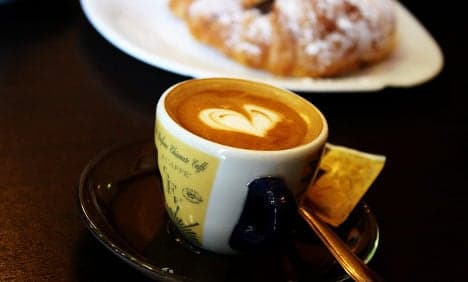
American journalist John Henderson went from despising the taste of coffee to loving it. And all because he moved to Rome. In his latest column for The Local, he explains the transition.
I once had a friend who worked for Vatican Radio and had one of the greatest handicaps for living in Rome. She was allergic to dairy products. Think about it. She couldn’t eat cheese. She couldn’t eat gelato. How can you live in Rome and not eat cheese or gelato? It’s like moving to the Caribbean and not being able to swim. I mean, what’s the point? Then again, when I moved to Rome, I had a big handicap, too, one that made Italians look at me as if I had a third eye.
I didn’t drink coffee.
I wasn’t allergic to it. I hated it. I loathed it. I didn’t like any hot liquids. Hot chocolate. Saki. Hot spiced wine. But coffee topped the list of disgusting beverages. Bitter and drab, it did nothing but make me thirsty. And I viewed all fluids as a means to quench a thirst. Nothing else. During an all-night writing marathon, caffeine had all the effect on me as Pez.
When I moved to Rome the first time in 2001, I made a tough decision. I love hanging out in piazzas. They are what separates Rome from every city in the world. It’s what makes living in Rome like living in a small town with a big city right across the street. I also love wine. But drinking wine all day in a piazza is problematic.
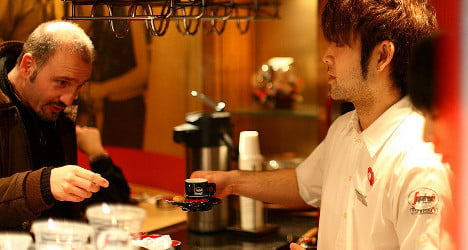
Photo: Conto di Luna/Flickr
Three or four times a week I’ll walk two blocks to my local cafe, Linari, and stand at the counter with a cappuccino and a perfect chocolate cornetto. If I stay long enough I’ll probably see more than half my Testaccio neighborhood, all gossiping away in the Romanaccio version of Italian that I have no hope of ever understanding.
To live in Italy, one must do more than drink coffee. One must understand coffee. When you visit Italy, order a coffee in one of the following ways:
Caffe
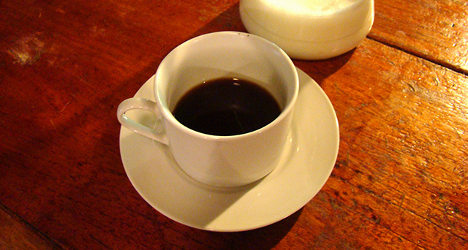
Photo: Montroyaler/Flickr
This is the most common yet the most shocking to Americans. It is a simple shot of espresso that fills about a third of a small cup just a bit bigger than a thimble. I still enjoy watching Americans’ jaws drop when they see it and ask, “Where’s the rest of it?” This isn’t Starbucks, Bubba. Thank God.
Caffe macchiato
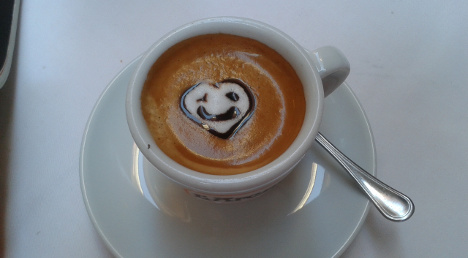
Photo: The Local Italy
This is halfway between a caffe and a cappuccino. It’s a caffe stained with a little spot of milk. Pronounce it correctly, mock-ee-OTTO, and you’ll be treated like a local.
Cappuccino
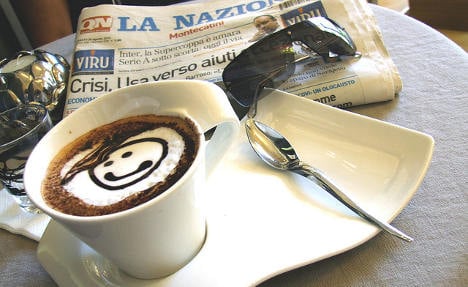
Photo: Art Crimes/Flickr
The classic Italian coffee. Espresso coffee covered in warm milk then topped with creamy foam, it is the perfect way to start the Italian day. Please note the word “start.” Do NOT, even if the craving eats at you like a heroin withdrawal, order a cappuccino after noon. Only tourists do that. Yes, you’re a tourist. Just don’t act like a stupid one.
Cappuccino ben caldo.
“Ben caldo” means “extra hot.” This is my favorite. Italians like to drink their coffee fast and don’t like it so hot it singes their tongues like American coffee. I like mine with a newspaper.
Marochino.
A small cappuccino sprinkled with chocolate, popular with Italian teen-agers and wimpy American expats.
Ristretto
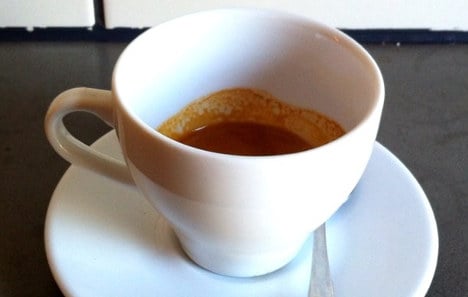
Photo: Petter Palander/Flickr
A shorter, very strong shot of espresso and isn’t much more than a sip. It should not be confused with ristretto’s other meaning: What happens to a man’s penis when he comes out of the cold Adriatic Sea.
Americano.
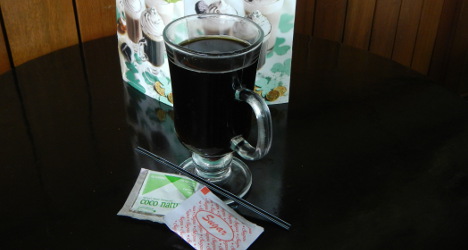
Photo: Ramon FVelasquez/Wikicommons
A long black coffee that, in more than three years in Rome over two stints, I have never seen an Italian order unless he lost a bet.
Read more: An essential guide to Italian coffee culture
It’s a long list. However, it’s nothing compared to that coffee stain on the international coffee landscape: Starbucks.
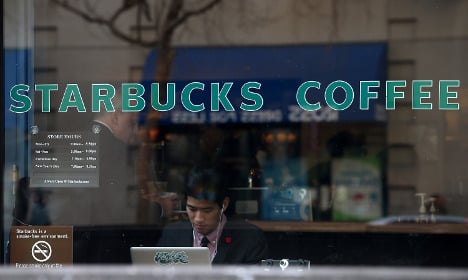
Photo: Justin Sullivan/AFP
It was Italy, and more pertinently, the country’s coffee culture, that inspired Howard Shultz to start his Starbucks empire 33 years ago, and despite opposition, the company will open its first store in Milan in 2017.
Read more: Frothing up Italian coffee: Starbucks is on its way
A big reason I once thought of drinking coffee in the same terms as drinking snake blood is because of Starbucks. Its coffee is as bitter as a Hollywood divorce and nearly as expensive.
And while it has a nice variety of recipes, they were contrived in a corporate office in Seattle.
Meanwhile, Italian coffee has been passed down from generations since it arrived in Venice in the mid-16th century. Go ahead. Walk into a rough-and-tumble bar in Rome and order an “iced, half-caff, ristretto, venti, four-pump, sugar free, cinnamon, dolce soy skinny latte.” (Yes, someone at Starbucks really ordered this once.) You’ll get tossed out right onto your Yankees cap.
My biggest problem with big coffee chains is that they've ruined many neighbourhoods. Cafes should have a family feel. Each should be different. They should be warm, cozy, with the atmosphere that makes you want to stay and chat or read for a few hours.
If you live in Italy — even if you visit — the first thing you must do is establish a local cafe. It’s where every Italian’s day begins. It’s a slice of true Italian culture as genuine as a British pub. You chat with the owner and your favorite barrista. You pick up a spare newspaper lying around and bitch to the guy next to you about A.S. Roma’s last heartbreaking loss.
The above article was shared with The Local Italy by John Henderson, a journalist living in Rome and the author of Dog-Eared Passport.
Comments
See Also
I once had a friend who worked for Vatican Radio and had one of the greatest handicaps for living in Rome. She was allergic to dairy products. Think about it. She couldn’t eat cheese. She couldn’t eat gelato. How can you live in Rome and not eat cheese or gelato? It’s like moving to the Caribbean and not being able to swim. I mean, what’s the point? Then again, when I moved to Rome, I had a big handicap, too, one that made Italians look at me as if I had a third eye.
I didn’t drink coffee.
I wasn’t allergic to it. I hated it. I loathed it. I didn’t like any hot liquids. Hot chocolate. Saki. Hot spiced wine. But coffee topped the list of disgusting beverages. Bitter and drab, it did nothing but make me thirsty. And I viewed all fluids as a means to quench a thirst. Nothing else. During an all-night writing marathon, caffeine had all the effect on me as Pez.
When I moved to Rome the first time in 2001, I made a tough decision. I love hanging out in piazzas. They are what separates Rome from every city in the world. It’s what makes living in Rome like living in a small town with a big city right across the street. I also love wine. But drinking wine all day in a piazza is problematic.

Photo: Conto di Luna/Flickr
Three or four times a week I’ll walk two blocks to my local cafe, Linari, and stand at the counter with a cappuccino and a perfect chocolate cornetto. If I stay long enough I’ll probably see more than half my Testaccio neighborhood, all gossiping away in the Romanaccio version of Italian that I have no hope of ever understanding.
To live in Italy, one must do more than drink coffee. One must understand coffee. When you visit Italy, order a coffee in one of the following ways:
Caffe

Photo: Montroyaler/Flickr
This is the most common yet the most shocking to Americans. It is a simple shot of espresso that fills about a third of a small cup just a bit bigger than a thimble. I still enjoy watching Americans’ jaws drop when they see it and ask, “Where’s the rest of it?” This isn’t Starbucks, Bubba. Thank God.
Caffe macchiato

Photo: The Local Italy
This is halfway between a caffe and a cappuccino. It’s a caffe stained with a little spot of milk. Pronounce it correctly, mock-ee-OTTO, and you’ll be treated like a local.
Cappuccino

Photo: Art Crimes/Flickr
The classic Italian coffee. Espresso coffee covered in warm milk then topped with creamy foam, it is the perfect way to start the Italian day. Please note the word “start.” Do NOT, even if the craving eats at you like a heroin withdrawal, order a cappuccino after noon. Only tourists do that. Yes, you’re a tourist. Just don’t act like a stupid one.
Cappuccino ben caldo.
“Ben caldo” means “extra hot.” This is my favorite. Italians like to drink their coffee fast and don’t like it so hot it singes their tongues like American coffee. I like mine with a newspaper.
Marochino.
A small cappuccino sprinkled with chocolate, popular with Italian teen-agers and wimpy American expats.
Ristretto

Photo: Petter Palander/Flickr
A shorter, very strong shot of espresso and isn’t much more than a sip. It should not be confused with ristretto’s other meaning: What happens to a man’s penis when he comes out of the cold Adriatic Sea.
Americano.

Photo: Ramon FVelasquez/Wikicommons
A long black coffee that, in more than three years in Rome over two stints, I have never seen an Italian order unless he lost a bet.
Read more: An essential guide to Italian coffee culture
It’s a long list. However, it’s nothing compared to that coffee stain on the international coffee landscape: Starbucks.

Photo: Justin Sullivan/AFP
It was Italy, and more pertinently, the country’s coffee culture, that inspired Howard Shultz to start his Starbucks empire 33 years ago, and despite opposition, the company will open its first store in Milan in 2017.
Read more: Frothing up Italian coffee: Starbucks is on its way
A big reason I once thought of drinking coffee in the same terms as drinking snake blood is because of Starbucks. Its coffee is as bitter as a Hollywood divorce and nearly as expensive.
And while it has a nice variety of recipes, they were contrived in a corporate office in Seattle.
Meanwhile, Italian coffee has been passed down from generations since it arrived in Venice in the mid-16th century. Go ahead. Walk into a rough-and-tumble bar in Rome and order an “iced, half-caff, ristretto, venti, four-pump, sugar free, cinnamon, dolce soy skinny latte.” (Yes, someone at Starbucks really ordered this once.) You’ll get tossed out right onto your Yankees cap.
My biggest problem with big coffee chains is that they've ruined many neighbourhoods. Cafes should have a family feel. Each should be different. They should be warm, cozy, with the atmosphere that makes you want to stay and chat or read for a few hours.
If you live in Italy — even if you visit — the first thing you must do is establish a local cafe. It’s where every Italian’s day begins. It’s a slice of true Italian culture as genuine as a British pub. You chat with the owner and your favorite barrista. You pick up a spare newspaper lying around and bitch to the guy next to you about A.S. Roma’s last heartbreaking loss.
The above article was shared with The Local Italy by John Henderson, a journalist living in Rome and the author of Dog-Eared Passport.
Join the conversation in our comments section below. Share your own views and experience and if you have a question or suggestion for our journalists then email us at [email protected].
Please keep comments civil, constructive and on topic – and make sure to read our terms of use before getting involved.
Please log in here to leave a comment.